Come spirit! Come charm! Come days that are warm! Come magical spell— they will help you get well! Come to their garden for the most extraordinary theatrical experience that is so stunning, so professional, and so polished you’ll find it hard to believe that it’s a community organization and playing in a church nonetheless! The Secret Garden now live in living color is appearing through the weekend of March 17th with the Woods Memorial Presbyterian Church and it is beyond remarkable, truly mind-blowing, and absolutely astonishing to the point where finding enough adequate words to fully express how impressive this show is has been quite the challenge. Directed/Musical Directed by David Merrill with Choreography and Assistant Direction from Elysia Merrill, this striking tale of sorrow and beauty sends shivers up your spine and truly transports the audience into the tale in the way that we have all been told only theatre can do.
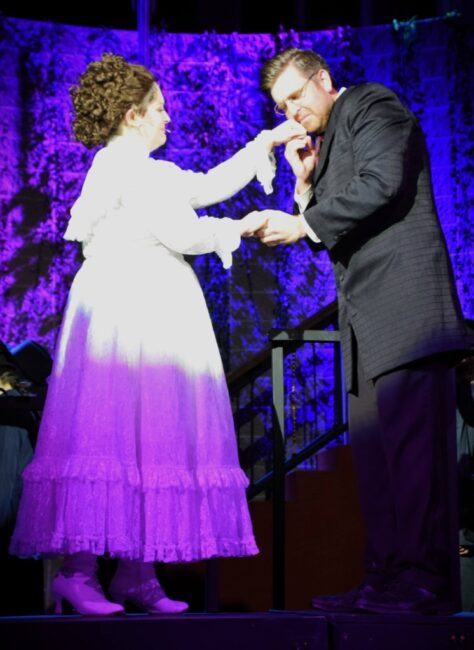
Where does one even begin with a show that is so carefully and meticulously nuanced so that every facet is practically perfect? One of the most amazing features of all is the symphonic quality orchestra that plays throughout the performance. I asked several different members of the production staff multiple times (in complete seriousness) whether or not they were players on loan from the BSO or NSO; they sound that flawless, that professional, and that extraordinary. Conducted by Chris Pinder, the orchestra: Mari Hill on woodwind1, Heidi Schultz on woodwind2, Rich Estrin on woodwind3, Myrlon Pressly on horn1, Diana Ogilvie on horn2, Allyson Wesley on trumpet, Mike Allman on trombone, Doug Byerly on keys1, Trent Goldsmith on keys2, Hyejin Kim on violin1, Melody Flores & Anthony Shields on violin2, Lorraine Combs on viola, Mike Dawson on bass, Jeremy Ulrich on percussion— creates glorious sounds with the music of Lucy Simon. The way their swells fill that space, creating this immersive, all-encompassing sound bath, which supports and augments the performers in perfect balance is utterly unfathomable because you only expect sound of this caliber and quality at a place like the symphony and yet here it is, washing through the house, engaging your ears from the overture through the curtain call in this blissful wave of musical excellence. Each of these instrumentalists brings a glorious sound all throughout the performance, though the magical Mari Hill adds just a hint more of whimsy, chirping away as ‘The Robin’ (who is puppeted with felicitous glee and joyous enthusiasm by the sprightly Joelle Lengbeyer.)
Director David Merrill has this vision, which is wholly supported by his production team. There is no ‘stage’ per say, but the Set Team (Pete Bishop and John Dawson) gives you theatrical magic and welcomes you to the epitome of what ‘suspend your disbelief’ should always mean whenever you attend a production. One of the most brilliant features in this production are the moving platforms/staircase and of course the garden trellis-arches. When Mary Lennox is chasing her way through the maze there is this dizzying choreographed dance (Elysia Merrill working in tandem with David as both the assistant director and choreographer for the show) of trellis-arches that move to ‘create the illusion’ of the maze. It’s just so stunning and so flawlessly executed that the giddy anticipation of Mary on the run becomes palpable and you can feel your heart racing along with her. The moving platforms, which are guided to and fro by members of the ensemble (often times the ‘spirits’, which adds another layer of symbolism to the production as a whole) gives you this transportive sensation like you’re watching scenes and time shift and pass before your eyes all through the simplistic movement of actors on platforms being pushed by other actors. It’s theatrical basics at its finest but it’s done with such a refined poise and sense of fluidity that it’s just stunning. There are so many impressive components to the show— the portrait of Lily on the wall and the fabrication of the garden stumps (as done by Kelly Kuethe, Matthew Walter, Elysia Merrill) or the overall scenic painting (Jane Ferguson)— you find yourself in a delightfully dizzying array of visual stimuli. All of these people are working together to bring David Merrill’s nuanced vision of The Secret Garden to vivacious life and it’s working.
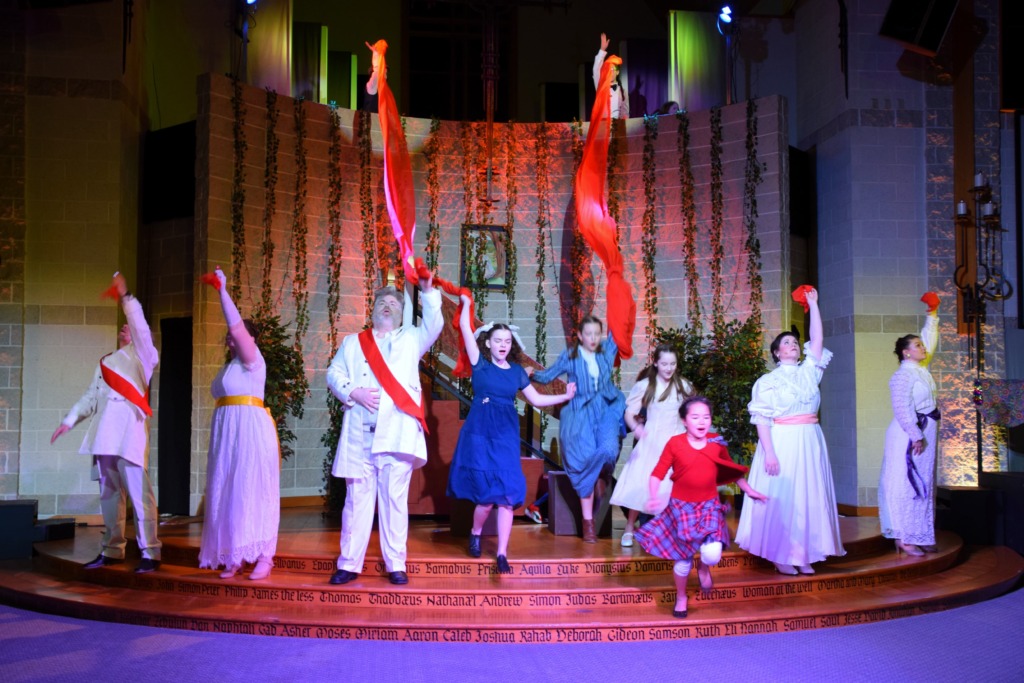
Merrill’s blocking of the show goes above and beyond in the creativity department in addition to being thoughtfully placed for consideration of sight lines and spatial awareness. There are over 50 people in the cast and never once do you feel a sense of overcrowding or ill-spaced placement. The attention to detail in the blocking, the choreography, and overall use of the space alone is by far the best I’ve seen in community theatre in a very, very long time. Merrill makes use of the whole sanctuary— the top tier of the pulpit wall often features the ever-present on-looking spirit or scenes in flashback. The aisles serve as pathways for characters to filter around and through the audience to the centralized play space, and the way the performers move in the space gives you this sense that Merrill & Merrill have instilled a consciousness to them that this is their playground, their world of wonder, and we theatergoers are invited to witness wholeheartedly the mesmerizing story that they’re living.
Elysia Merrill’s choreography is inspiring. The moment that comes immediately to mind is the way she juxtaposes darkness and light during “Where in the World” a song sung by Archibald late in the second act. The entire production is filled with spirits in white (and gorgeous glowing lights but we’ll get to that in a moment); so when these ‘dancing shadows’ appear for the first time in all black, with faces obscured, it’s blindsiding. The symbolic representation of the darkened demons that haunt Archibald’s soul when he’s away from the home is powerful and the movement of these dancers is jarring and erratic, which serves as a superb contrast to all of the more fluid dance routines that Merrill utilizes throughout the production up to that point. Merrill infuses spirit into all of the routines— everything from the ethereal senses of ancient magic before time during “Come Spirit, Come Charm” to the hypnotic movements of the Ayahs (Anya Lengbeyer and Cassia Lengbeyer) which happens frequently throughout the performance. Anya and Cassia Lengbeyer pop up on the pulpit wall or beside Mary and let their bodies blow like warm breezes; it’s extraordinary. Both Lengbeyer girls are a part of the ‘Dance Ensemble’, which also includes Morgan Binnix, Adrielle Brooks, Cole German, Lisa Pellittere, Meridian Toalpai, Violet Thompson, Elda Trombley, and Jenisis Vidale. All of these dancing ensemble members appear with vigorous presence throughout the performance and are wonderful to behold in their movements.
As mentioned, the spirits are aglow with heavenly light. Whenever you see the likes of Lily or Rose, the lieutenants and others who vanished during the cholera outbreak in India, they are lit from within the confines of their costumes by tiny glowing faerie lights. The effect is stellar. (You get a similar gasp-worthy effect near the end of the performance but that would be a true spoiler to give it away.) Costumes on the whole, as overseen and assembled by Susan Bohlman and her assistants Julie Klug and Jean Zemo, are resplendent. The production is awash in the white, healing light of angels and so the costumes of the spirits— period appropriate and fitted to each performer— are no exception. The living— like the Craven brothers and all other entities of the household and grounds— are dipped in shades of shadows, sorrow, and darkness. The contrast is visually astonishing. Adding to the perfectly polished aesthetic of the show are Lisa Lyons, Valerie Werner, and Kaitlin Arnold, with their work and consultation on Hair and Make-up. You feel as if you are living in the turn of the 20th century.
Properties Master Macy Toalepai and coordinator Nancy Bishop add subtle visual delicacies to the scenes, particularly those in the garden. And there is true mastery in Puppet Fabricator Trishelle Weed’s work (assisted by Scott Wiley.) The children and teen ensemble take up over a dozen hand-crafted animal creature puppets, all of which are dazzling to behold, and it adds an incredible sense of chimerical bliss to the scenes where they are present. The teen & children’s ensemble (Bill Dodson, Hadley Dodson, Oceana Dupree, Riah Dupree, Avery Jackson, Madelyn Luebbers, Joelle Lengbeyer, Sabina Lengbeyer, Sabrina Monteith, Mallory Owen, Victoria Shute, Payton Story, Christine Snipes, Harper Wright, Gabriella Dillenback) features energetic young performers giving all of their joy and vibrations to these puppets— there’s even a dragon (which appears during “Race You to the Top of the Morning”) and there aren’t enough words to describe all the wondrous, beautiful, things happening with these puppets and the energy that these young performers are giving to them.
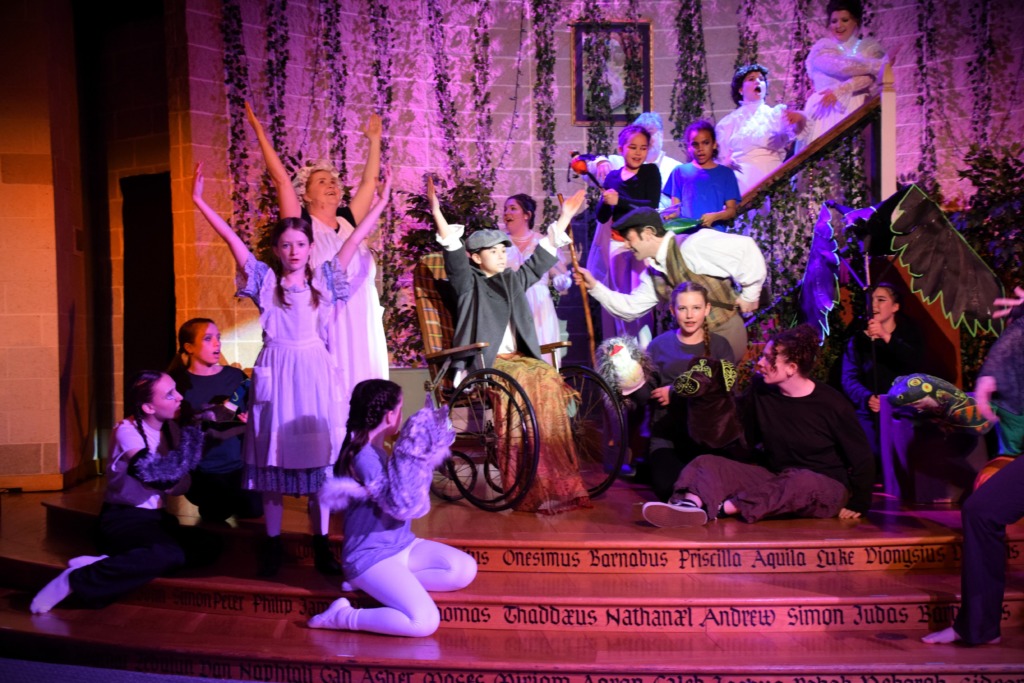
Tying the overall aesthetic of the production together, including some of the special UV-paint effects on the aforementioned puppets, is the show’s lighting design (also David & Elysia Merrill) alongside the breathtaking projections/slide show which are displayed on two large screens which flank either side of the center play-space. You get the gardens, the house, the moors, and then some— and the magic that gets worked into revealing these scenes (often with young Dickon waving his arms or his divining rod and the scenes just melting away into place) is a phenomenal thing to experience. There aren’t enough words to describe how moments like the storm (all three of its incarnations) come together in perfect syzygy of lights and sound (designed by Alec Green) moving as one performance element.
The Spirit Ensemble (Kayleigh Berkoski, Elizabeth Darby, Emily Havnewitz, Erics Snipes, Teagan Yokanovich) who often appear with those in full white from the cholera incident (Joe Rose as Lieutenant Shaw, Dean Davis as Lieutenant Wright, April Currey as Claire Holmes, David Thompson as Major Holmes, Andy Kay Wojciehowski as Alice, Chris Swift as Major Shelly, Lindsey Miller as Mrs. Shelly) brings haunting ephemeral sounds to all three sections of “The Storm.” There are moments during each of those iterations of “The Storm” where the way their voices blend together in perfection and swell to a crescendo sends chills up the spine and goosebumps to the arm. April Currey and Andy Kay Wojciehowski even have a moment atop the pulpit turret where they get an beautifully eerie solo-style duet and it will ring through mind long after the evening is gone. “The House Upon the Hill” and “I Heard Someone Crying” is populated with these majestic yet morose sounds of tragic beauty that truly sound like they’ve come from a professionally trained and blended cathedral choir.
Mixing these sounds with the House Attendants (Ami Dawson, Joyce Dawson, Kirsty Dillenback, Angela Germanos, Angela Popernack, Thomas Shade) and the Adult Choir (Dan Atkinson, Corrine Baker, Pete Bishop, Nancy Bishop, Pete Cooper, Sue Cooper, Julia Erickson, Kim Erickson, Mary Jo Greenley, Stacey Hilder, Jenny Henry, Doug Irminger, Jane Merrill, David Nelson, Marilyn Pollock, Sarah Thompson, David Thompson, John Williams, Delight Yokanovich) results in the remarkable sounds you hear throughout the performance. It’s more than astonishing to hear the vocal perfection every time a song clips to life. And to that— the praises of dialect coach Mary Watko must be added for many of the principal performers adapt their vocality to thick accents of the locale and the time, carrying them with solidarity and consistency into their singing voices; I simply cannot express how professional it sounds. (And looks and feels when it comes to all the other components of this tremendous theatrical undertaking.)
With a dulcet vocal tone, Kevin Cleaver takes up the role of Albert Lennox and although his moments in song are reserved for once his character has passed into the spirit realm, you can still readily pick out his lovely voice during “A Bit of Earth (Reprise).” So too can be said for Kelly Kuethe, playing Rose. Though her true moment to sparkle vocally is as one quarter of the “Quartet” where you hear her shimmering vocals resonating with brilliance against that of the Craven brothers and dear Lily. Singing characters and speaking characters alike find their moment in the limelight in this production, not the least of which is Cristina Rose as Mrs. Medlock the housekeeper, who sets the tone of what the house will be like from the first moment she encounters Mary Lennox.
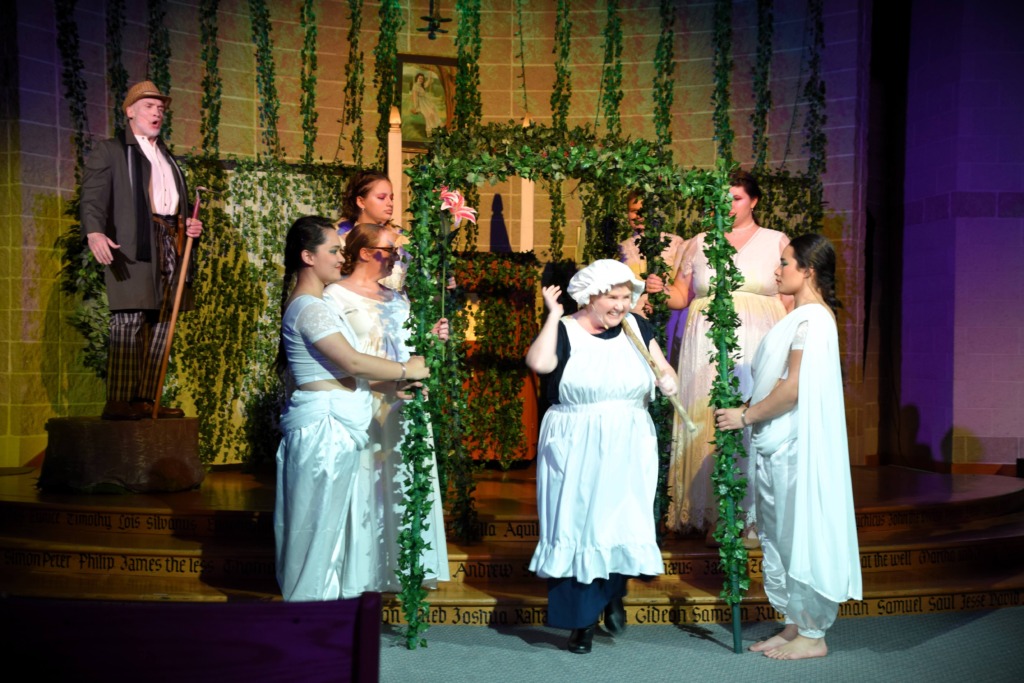
For as stalwart and standoffish as Rose’s Mrs. Medlock is, Sarah Mitchell’s Martha could not be more of a striking opposite. A delightful dollop of dreamy optimism, Mitchell’s Martha lilts her way through all the dreary darkness that come with the ‘house on the hill.’ Even when the lyrics in her numbers are slightly dissonant, you get this infectious effervescence, bubbling up out of Mitchell, first during “A Fine White Horse” and later during “Letter Song.” You feel your soul lift a little watching Mitchell in this role and she’s aces with the accent, carrying it through into the long sustain at the end of “Letter Song” and keeping it about her as if it were her natural way of talking whenever she speaks.
For a character who does precious little singing, you’re not likely to forget Ben (Scott Benedict), the old caretaker-gardener of the estate. Benedict strikes the perfect balance between salty old curmudgeon and deeply endearing caretaker. There’s an evenness about his portrayal that gives this supporting character an earnest depth and makes the role seem larger and more present than the script calls for.
The disgruntled character of Dr. Neville Craven (John Rose) could in the right light be viewed as villainous. John Rose takes this portrayal in a different direction and it works for the production exceedingly well. A man at the end of his tether because of the situation his family has landed him in, with unrequited, disquieted love, for a woman who chose the other brother and then left them both in death. Rose’s voice is perfectly suited for the music parsed to the Nevill character and he adds an exhilarating level of blending harmonies to his section of “Quartet.” Vocally dueling with Archibald during “Lily’s Eyes,”, the audience is brought to a thunderous ovation at the conclusion of this number.
As the ensorcelling Dickon, Matthew Walter is radiating vibes of a true wizard, one with the earth, one with the spirits, and one with a ton of heart. From the very beginning of the performance you get this notion that Walter’s Dickon is magic incarnate— the way he bewitches scenery to life both at the beginning and the end of the performance— and that he may look like a young lad, but is really something otherworldly. Both of his key numbers— “Wick” and “Come Spirit, Come Charm” are enchanting beyond compare and the lighthearted joviality which percolates in the very fibers of his being explode out into his voice, his body language, and his facial expressions— it’s a delightfully impish and playful interpretation of the character that just captures the quintessential heart of magic for not only Dickon but the production as a whole.
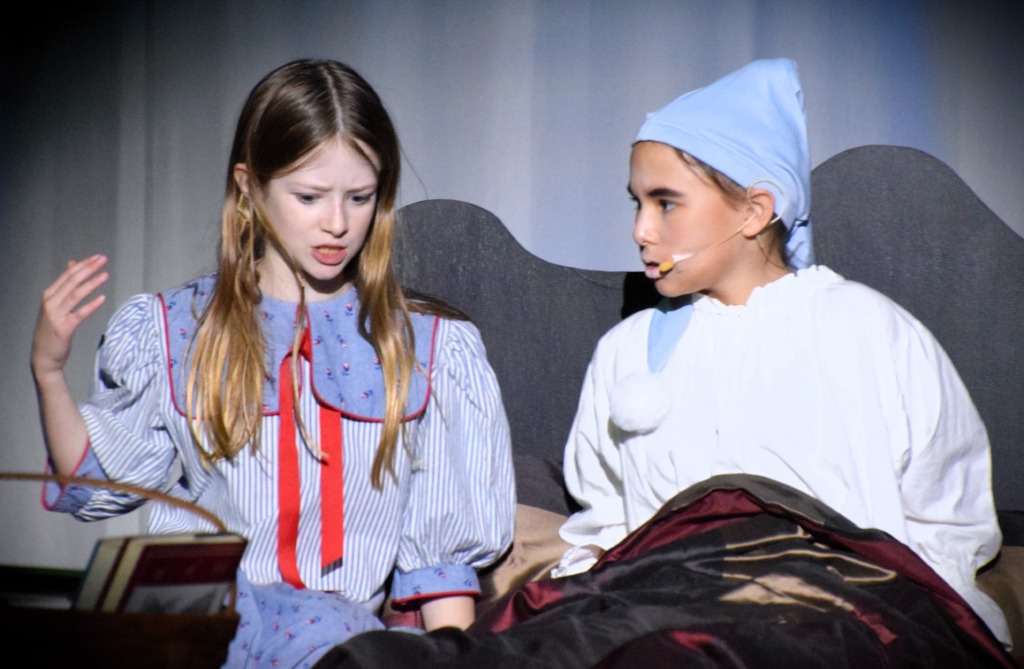
Little Colin (Tabitha Popernack) packs a mighty punch when it comes to being cross and pouty and all things unpleasant. The bristling dynamic between Colin and Mary Lennox (Grace Gavin) is done so well the audience couldn’t help but laugh whenever they fuss at one another. Popernack and Gavin alike maintain flawless accents throughout the performance and although Popernack is restricted by Marsha Norman’s libretto in how much the Colin character actually gets to sing and do, you get a very clear picture that Popernack is an incredibly talented young performer. “Come To My Garden” gives her the chance to clearly showcase her talents as does “Round-Shouldered Man”, and the moment she shares with Archibald Craven toward the end of the production is truly a tear-jerker.
Grace Gavin is a powerhouse force to be reckoned with both vocally and when it comes to her acting chops. Moody and sullen but with great propensity to displaying true character growth, Gavin delivers a stellar portrayal of Mary Lennox in all facets of the performance that one could hope for. With a crystal clear singing voice, numbers like “I Heard Someone Crying” and “Show Me The Key” becomes these mellifluous moments that just send your heart soaring. “The Girl I Mean to Be” showcases her vast vocal range as well as her ability to massage emotions into her songs. She’s got the energy and the attitude and the shift once the character grows, making her proper sensation upon the stage in this role of Mary Lennox.
When Emily L. Sergo appears immediately after the overture/prologue, high atop the tower-pulpit wall and she opens her mouth to sing the first few lines of “Opening Dream” it’s like you’re in heaven. Her operatic quality voice is so serene, so blissfully beautiful while simultaneously being haunting and sad that you shiver and weep all at once. Sergo entrances the audience every time she sings, that angelic sound drifting out to the audience in ways that defy description; you have to hear it to understand its beauty. When she finally falls into the duet with Archibald, “How Could I Ever Know” it brings tears to the eyes. The passion, the pathos, the longing, the reverence of the conclusion of the story is all there wrapped up in her voice and in his and it one of the most emotionally expressive and heartfelt performances I’ve had the pleasure to witness.
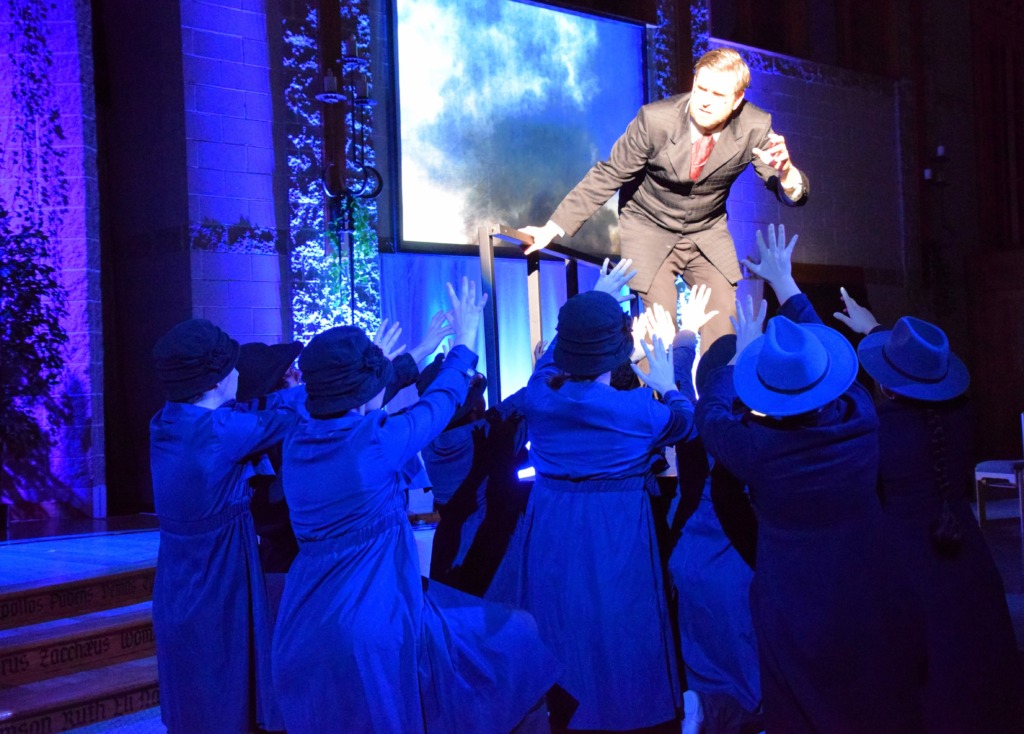
Most actors have to work very hard for a role to be a success, even more so when that actor is doubling up as the show’s director. David Merrill masters the art of making the role do the work for him. He just is Archibald Craven from the moment he slides onto the stage. There’s a haunted, tortured darkness inside of him but it doesn’t dominate the portrayal— as so often is the tendency when it comes to Archibald Craven. Merrill augments and highlights the internal struggle of Archibald Craven and the humanity that so desperately longs to be let loose from his soul. His jubilant rendition of “A Girl in the Valley” (yet another duet shared with the phenomenal Emily L. Sergo) puts the heartfelt glee of his character’s former life in a raw juxtaposition of the character’s present miserable existence. “A Bit of Earth” is a striking solo but is quickly outdone by Merrill’s performance of “Race You to the Top of the Morning” wherein you get a full gamut of emotional expressions racing through the lyrics as the number unfolds. “Lily’s Eyes” is truly the pièce de résistance when he sings this powerful, soul-searing ballad-duet opposite Neville. “Where in the World” has similar scorching sensations that just sends the audience; Merrill is a remarkably perfect fit for this role, both vocally and performatively because he gives you the whole existence of Archibald Craven and not just the withered remains of the character’s heart.
There aren’t enough words in the English language to describe the perfection that is this production. I cannot say it enough— book your tickets, book your tickets, book your tickets. This thing is beyond wick— it’s a true explosion of theatrical life. So you’ll be there to see it— stop and feel it— stop and hear it. You must book your tickets to The Secret Garden at Woods Memorial Presbyterian Church it is the most sensational thing to yet be on the stage in 2024.
Running Time: Approximately 2 hours and 30 minutes with one intermission
The Secret Garden plays evenings at 7:30 on March 10th, 15th, 16th, and 17th 2024 at Woods Memorial Presbyterian Church— 611 Baltimore Annapolis Blvd in Severna Park, MD. Tickets are $15 and seating is LIMITED!! In order to register for seats, please visit this website or if registration is full and you’d like to be placed on the waiting list, please call Pam Ward at 443-261-3263 or email her at pward@woodschurch.org
